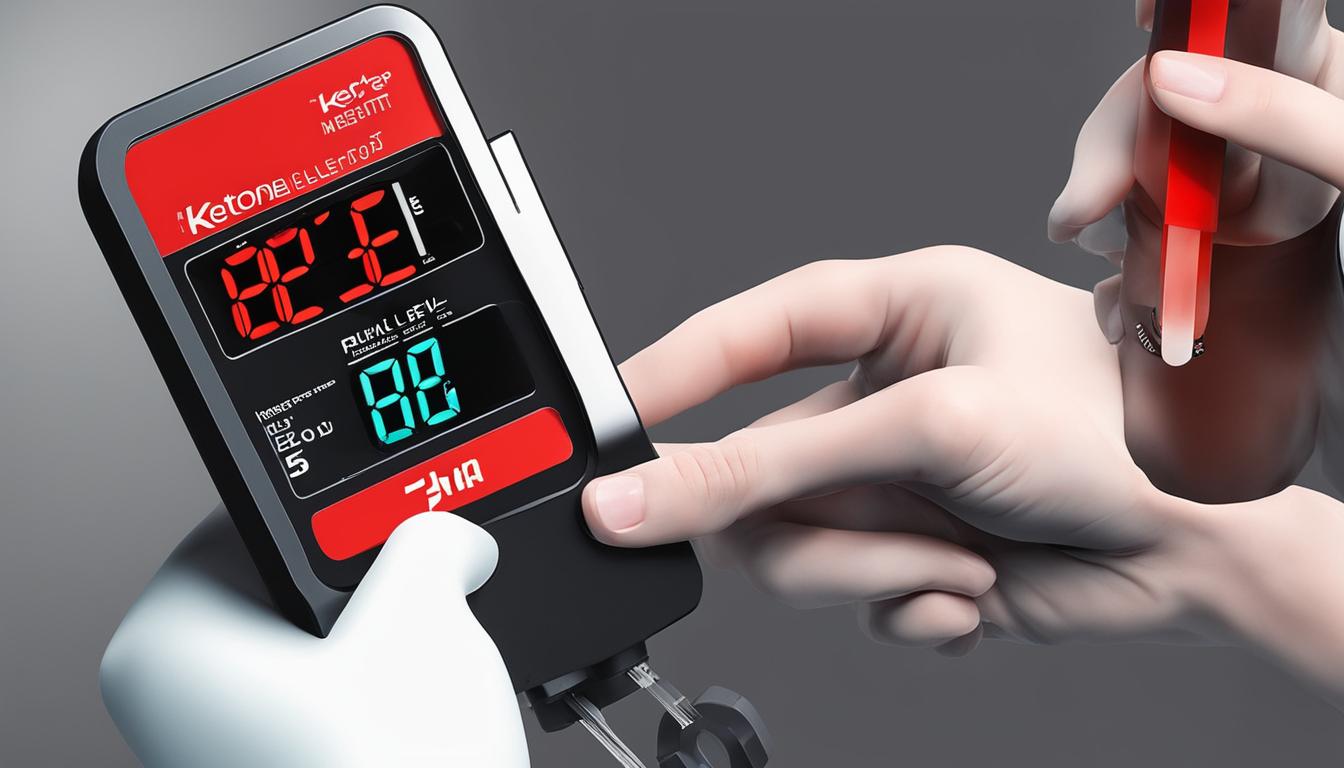The ketogenic diet is a popular low carb diet that aims to achieve nutritional ketosis, where the body switches its main fuel source from glucose to ketones. If you’re considering going into keto, you may wonder how long it takes to get into ketosis and what symptoms to expect. In this guide, we’ll explore the process of entering ketosis, how long it typically takes, common symptoms, and tips to help you achieve and maintain ketosis.
Key Takeaways:
- Entering ketosis involves transitioning the body from using glucose as its main fuel source to using ketones.
- It generally takes 2-4 days to enter ketosis by consuming fewer than 50 grams of carbs per day.
- Factors like physical activity level, age, metabolism, and carb, fat, and protein intake can affect the duration.
- Common symptoms of ketosis may include headache, fatigue, nausea, bad breath, and increased thirst.
- Testing ketone levels through urine, breath, or blood can confirm whether you’re in ketosis.
How Long Does It Take to Enter Ketosis?
The time it takes to enter ketosis can vary from person to person. In general, it takes 2-4 days if you consume fewer than 50 grams of carbs per day. However, some individuals may take longer, especially if they were on a high carb diet before starting keto. Depleting glycogen stores is necessary before entering ketosis. Factors like physical activity level, age, metabolism, and carb, fat, and protein intake can influence the duration.
Factors Affecting Entry into Ketosis
Several factors can influence the time it takes to enter ketosis. These include:
- Physical activity level: Regular exercise and higher levels of physical activity can help deplete glycogen stores and speed up the transition into ketosis.
- Age: Younger individuals may enter ketosis faster compared to older individuals.
- Metabolism: A higher metabolic rate can potentially facilitate faster ketosis.
- Diet composition: Consuming adequate amounts of fat and moderate protein, while limiting carbohydrate intake, can help facilitate the switch to ketosis.
It’s important to note that these factors are unique to each individual and may vary. Monitoring your body’s response and adjusting your approach accordingly can help optimize the time it takes for you to enter ketosis.
Signs of Ketosis
As the body transitions into ketosis, it may exhibit several symptoms commonly referred to as the “keto flu.” These symptoms are a sign that your body is adjusting to using ketones as its primary source of fuel instead of glucose. Some of the common signs of ketosis include:
- Headaches: You may experience mild to moderate headaches as your body adapts to the changes in energy metabolism. These headaches are temporary and usually resolve within a few days.
- Fatigue: During the initial stages of ketosis, you may feel more tired or fatigued than usual. This is because your body is transitioning to a new energy source.
- Nausea: Some individuals may experience nausea or digestive discomfort as their body adjusts to the higher fat intake and lower carbohydrate consumption.
- Bad breath: Ketones produced during ketosis can cause a distinct fruity or metallic odor in your breath. This is often referred to as “keto breath” and is a common sign of ketosis.
- Increased thirst: Ketosis can lead to increased water loss, resulting in dehydration. As a result, you may feel more thirsty than usual.
It’s important to note that not everyone will experience all of these symptoms, and the intensity and duration may vary from person to person. However, if you are experiencing these signs, it’s a good indication that your body is entering ketosis.
Testing Ketone Levels
One of the key factors in determining whether you’re in ketosis is measuring your ketone levels. There are various methods available to test your ketone levels, each with its own advantages and considerations.
1. Urine Testing Strips:
Urine testing strips are a popular and inexpensive option for testing ketones. They work by detecting the presence of acetoacetate, a ketone body, in your urine. To use, simply hold the strip in your urine stream or dip it into a urine sample. The strip will change color to indicate the level of ketones in your body. However, it’s important to note that urine testing strips may not provide the most accurate measure of ketone levels, as they only reflect the excess ketones that your body is excreting.
2. Ketone Breath Meters:
An alternative method to test ketone levels is using a ketone breath meter. These devices measure the levels of acetone, a ketone byproduct, in your breath. Simply breathe into the meter and wait for the reading. Ketone breath meters are fairly accurate and provide a non-invasive way to monitor your ketone levels. They are ideal for frequent testing and can be used on the go.
3. Blood Ketone Meters:
The most accurate method for testing ketone levels is using a blood ketone meter. This device measures the level of beta-hydroxybutyrate (BHB) in your blood, which is the main ketone produced during ketosis. To use, you’ll need a lancet to prick your finger and draw a small blood sample. Insert the sample into the meter, and it will provide you with an accurate reading of your ketone levels. Blood ketone meters are widely considered the gold standard for ketone testing and are often used by healthcare professionals.
Optimal Ketone Range:
The optimal range for maintaining ketosis is generally considered to be between 1.5-3.0 mmol per liter of blood. However, it’s important to note that individual ketone levels can vary, and what works for one person may not work for another. It’s best to consult with a healthcare professional or a knowledgeable expert to determine the optimal ketone range for your specific goals and circumstances.

Factors Affecting Entry into Ketosis
Several factors can influence the time it takes to enter ketosis. Let’s take a closer look at why it can take longer for some individuals to enter ketosis and the factors that affect the process.
Age and Metabolism
Age plays a role in the speed at which you enter ketosis. Generally, younger individuals tend to enter ketosis more quickly than older individuals due to differences in metabolism. As we age, our metabolism naturally slows down, which can delay the transition into ketosis.
Exercise Level
Your exercise level can also impact how long it takes to enter ketosis. Regular physical activity helps deplete glycogen stores in your muscles, making it easier for your body to switch to ketones as a fuel source. Those who engage in regular exercise may enter ketosis more quickly than those who lead a sedentary lifestyle.
Diet Composition
The composition of your diet, specifically the amounts of carbohydrates, protein, and fat you consume, affects the time it takes to enter ketosis. Consuming more carbohydrates than the recommended amount for a ketogenic diet can delay ketosis as your body will continue to rely on glucose for fuel. Not eating enough fat or consuming excessive amounts of protein can also hinder ketosis.
| Factors | Effect on Ketosis Entry |
|---|---|
| High carbohydrate intake | Delays ketosis |
| Inadequate fat intake | Hinders ketosis |
| Excessive protein intake | Affects ketosis |
Lifestyle Factors
Various lifestyle factors can impact the duration it takes to enter ketosis. Proper sleep, managing stress levels, and maintaining a healthy lifestyle overall can contribute to a smoother transition into ketosis. Lack of sleep and high-stress levels may hinder the process and prolong the time it takes to enter ketosis.
Quote:
“The time to enter ketosis can vary from person to person, depending on factors such as age, exercise level, and diet composition.”
In conclusion, the time it takes to enter ketosis can vary due to several factors, including age, metabolism, exercise level, diet composition, and lifestyle. By understanding these factors, you can better navigate your ketogenic journey and work towards achieving your desired state of ketosis.
Considerations Before Going Keto
Before embarking on a keto diet, it’s important to carefully consider the potential risks and downsides involved. Although the diet may lead to rapid weight loss initially, it’s essential to understand that this weight loss may be primarily due to water loss rather than fat loss. Additionally, the long-term health implications of following a keto diet are not yet fully understood.
There are several risks associated with ketosis that should be taken into account. One such risk is the development of fat buildup in the liver, which can lead to liver disease if left unchecked. Another consideration is the potential for the formation of kidney stones due to the increased excretion of certain substances in the urine while in ketosis.
Furthermore, it’s important to be cautious about inadequate protein levels while on a keto diet. Insufficient protein intake can lead to muscle loss and other negative effects on overall health. Vitamin deficiencies, particularly in vitamins B and C, are also a concern, as the restricted food choices on a keto diet may limit the intake of these essential nutrients.
“Inflammation and oxidative stress are potential risks of long-term ketosis. The strict limits of the diet may also pose challenges for individuals in terms of adherence.”
Inflammation and oxidative stress are potential risks associated with long-term ketosis, as the diet may not provide sufficient antioxidants to counteract these processes. Additionally, the strict limits on carbohydrate consumption may present challenges and difficulties for individuals in terms of maintaining compliance with the diet.
It is important to note that individuals with certain health conditions, such as diabetes, pancreatitis, or gallbladder disease, as well as those taking medications that affect blood sugar levels, should consult with a healthcare professional before attempting a keto diet. This is crucial to ensure that the diet does not interfere with their condition or medication regimen.
| Considerations Before Going Keto | Risks and Downsides |
|---|---|
| Rapid initial weight loss | Primarily due to water loss |
| Unknown long-term health implications | Research still ongoing |
| Fat buildup in the liver | Possible risk of liver disease |
| Kidney stone formation | Due to altered urine composition |
| Inadequate protein levels | Possible muscle loss |
| Vitamin deficiencies | Particularly vitamins B and C |
| Inflammation and oxidative stress | May be increased |
| Challenges with adherence | Strict limits on carbohydrate intake |
When considering the keto diet, it’s crucial to make an informed decision that takes into account your unique circumstances and health status. Consulting with a healthcare professional can provide personalized guidance and ensure that the diet aligns with your individual needs and goals.
Tips to Achieve Ketosis
If you’re struggling to get into ketosis, there are several tips that can help you reach this metabolic state faster and more effectively. By implementing the following strategies, you can increase your chances of achieving ketosis and experiencing the benefits of the ketogenic diet:
- Reduce Carbohydrate Intake: Limit your daily carbohydrate consumption to 20-50 grams. This low-carb approach encourages your body to shift from relying on glucose as its primary fuel source to relying on ketones.
- Increase Physical Activity: Engage in regular exercise or physical activity to deplete your glycogen stores. This depletion helps facilitate the transition to ketosis.
- Intermittent Fasting: Incorporate periods of fasting into your eating schedule. Intermittent fasting promotes fat burning and can expedite the entry into ketosis.
- Consume Healthy Fats: Include more healthy fats in your diet, such as avocados, nuts, seeds, and olive oil. These fats provide the necessary fuel for your body to produce ketones.
- Test Ketone Levels: Monitor your ketone levels using urine, breath, or blood testing methods. This allows you to track your progress and make adjustments to your diet or lifestyle as needed.
- Adjust Protein Intake: Ensure that your protein intake is moderate and within the appropriate range for your individual needs. Consuming excessive protein can hinder ketosis by converting amino acids into glucose through a process called gluconeogenesis.
- Consider MCT Oil: Incorporate medium-chain triglyceride (MCT) oil into your diet. MCT oil is rapidly converted into ketones by the liver, helping to boost ketone production and facilitate the state of ketosis.
By following these tips, you can optimize your chances of achieving ketosis and reaping the benefits of the ketogenic diet.

Benefits of the Keto Diet
The keto diet, short for ketogenic diet, offers numerous health benefits that go beyond weight loss. By drastically reducing carbohydrates and increasing fat intake, the body is forced to enter a metabolic state called ketosis, where it begins to burn fat for fuel instead of glucose. This shift in metabolism has been linked to several positive effects on overall health and well-being.
Weight Loss
One of the primary benefits of the keto diet is its effectiveness in promoting weight loss. By restricting carbohydrates, the body is depleted of its glycogen stores and begins to burn stored fat for energy. This can lead to significant weight loss, especially in the initial stages of the diet.
Improved Cholesterol Levels
Research has shown that the keto diet can lead to improved levels of high-density lipoprotein (HDL) cholesterol, commonly referred to as “good” cholesterol. Higher levels of HDL cholesterol are associated with a reduced risk of heart disease and stroke.
Reduced Blood Sugar and Insulin Levels
Following a keto diet can help stabilize blood sugar levels and reduce insulin resistance. By limiting carbohydrate intake, blood sugar spikes are minimized, leading to more stable energy levels throughout the day. This can be particularly beneficial for individuals with diabetes or pre-diabetes.
Lowered Triglyceride Levels
Triglycerides are a type of fat found in the blood. High levels of triglycerides are associated with an increased risk of heart disease. The keto diet has been shown to lower triglyceride levels, potentially reducing the risk of cardiovascular complications.
Potential Health Benefits for Various Conditions
Emerging research suggests that the keto diet may have potential benefits for a range of health conditions. These include:
- Heart Disease: The keto diet’s ability to improve cholesterol and blood sugar levels may contribute to a reduced risk of heart disease.
- Cancer: Some studies suggest that the keto diet may help slow the growth of certain types of cancer cells. However, further research is needed.
- Epilepsy: The ketogenic diet has long been used as a treatment for drug-resistant epilepsy in children.
- Neurological Disorders: Preliminary research indicates that the keto diet may have potential benefits for conditions like Alzheimer’s disease and Parkinson’s disease.
- Polycystic Ovary Syndrome (PCOS): The keto diet may help regulate hormone levels and improve symptoms in women with PCOS.
While these potential benefits are promising, it’s important to note that more research is needed to fully understand the long-term effects and risks of the keto diet for these conditions.
| Benefits of the Keto Diet | Health Condition |
|---|---|
| Weight loss | Obesity and overweight |
| Improved cholesterol levels | Heart disease |
| Reduced blood sugar and insulin levels | Diabetes and pre-diabetes |
| Lowered triglyceride levels | Cardiovascular disease |
| Potential benefits in other conditions | Cancer, epilepsy, Alzheimer’s disease, Parkinson’s disease, polycystic ovary syndrome (PCOS) |
Note: The table above provides a summary of the potential health benefits associated with the keto diet in various conditions.
In conclusion, the keto diet offers numerous health benefits beyond weight loss. It has been associated with improved cholesterol levels, reduced blood sugar and insulin levels, lowered triglyceride levels, and potential benefits for conditions like heart disease, cancer, epilepsy, Alzheimer’s disease, Parkinson’s disease, and polycystic ovary syndrome (PCOS). However, more research is needed to fully understand the long-term effects and risks of the diet.
What Foods to Avoid and Eat on the Keto Diet
When following the keto diet, it’s essential to be mindful of the foods you consume. By avoiding high-carb options and focusing on keto-friendly choices, you can optimize your chances of entering and maintaining ketosis. Let’s take a look at the foods to avoid and the foods to eat on the keto diet.
Foods to Avoid on the Keto Diet
When on the keto diet, it’s crucial to steer clear of high-carb foods that can inhibit ketosis. Here’s a list of foods to avoid:
- Sugary foods: This includes candy, cookies, cakes, and other sweets.
- Grains and starches: Avoid wheat, rice, pasta, bread, and other grain-based products.
- Fruits (except berries in small portions): Limit your fruit intake as they tend to be higher in carbs.
- Legumes: This includes beans, lentils, and chickpeas.
- Root vegetables: Avoid high-carb vegetables like potatoes, carrots, and parsnips.
- Low-fat or diet products: These often contain hidden carbs or unhealthy additives.
- Some condiments or sauces: Read labels carefully to avoid hidden sugars and carb-laden ingredients.
- Unhealthy fats: Steer clear of processed vegetable oils, margarine, and trans fats.
- Alcohol: Alcoholic beverages can impede ketosis and are generally high in carbs.
- Sugar-free diet foods: These products often contain artificial sweeteners that can affect blood sugar and insulin levels.
Remember to thoroughly read food labels and be aware of hidden sources of carbs in packaged products.
Foods to Eat on the Keto Diet
To support ketosis and enjoy a balanced diet, focus on consuming the following keto-friendly foods:
- Meat: Enjoy beef, pork, lamb, poultry, and other meats.
- Fatty fish: Include salmon, trout, sardines, and mackerel in your diet.
- Eggs: Incorporate eggs into your meals in various ways.
- Butter and cream: Use these high-fat dairy products to add flavor and richness.
- Cheese: Enjoy a wide variety of cheese types in moderate portions.
- Healthy fats: Opt for olive oil, coconut oil, avocado oil, and other healthy fats.
- Nuts and seeds: Include almonds, walnuts, chia seeds, and flaxseeds for added crunch and nutrition.
Remember to prioritize whole, unprocessed foods whenever possible and stay hydrated by drinking plenty of water.
By understanding which foods to avoid and which foods to eat on the keto diet, you can make informed choices to support your journey into ketosis. Let’s move on to the final section where we sum up the key points of this article.
Conclusion
Entering ketosis is a fascinating and personalized journey that each individual experiences differently. Generally, it takes about 2-4 days of following a low-carb diet to reach ketosis, where the body shifts from using glucose as the main source of energy to utilizing ketones. However, several factors can influence the timeline, including age, metabolism, exercise level, and the composition of one’s diet.
It is essential to recognize the signs of ketosis, such as headaches, fatigue, nausea, bad breath, and increased thirst. To confirm whether you have successfully entered ketosis, testing ketone levels through urine, breath, or blood can provide accurate results.
While the keto diet offers potential benefits like weight loss and improved cholesterol levels, it is crucial to be aware of the potential risks and downsides. Consulting with a healthcare professional before embarking on any significant dietary changes is highly recommended.
In conclusion, understanding the process of entering ketosis and being mindful of the influencing factors allows individuals to make informed decisions about their health and lifestyle. With proper knowledge and guidance, the keto diet can potentially contribute to improved well-being and support specific health conditions.
FAQ
How long does it take to enter ketosis?
It typically takes 2-4 days to enter ketosis by consuming fewer than 50 grams of carbs per day, but individual factors can affect the duration.
What are the signs of ketosis?
Symptoms of ketosis may include headache, fatigue, nausea, bad breath, and increased thirst.
How can I test my ketone levels?
You can test ketone levels through urine, breath, or blood. Urine testing strips, ketone breath meters, and blood ketone meters are common methods.
What factors can affect the time it takes to enter ketosis?
Factors such as age, metabolism, exercise level, and current carb, protein, and fat intake can influence the duration of entering ketosis.
What should I consider before starting a keto diet?
Before going keto, it’s important to be aware of the potential risks, downsides, and any specific health conditions or medications that may require consultation with a healthcare professional.
What tips can help me achieve ketosis?
Tips to achieve ketosis include significantly reducing carbohydrate intake, increasing physical activity, intermittent fasting, consuming more healthy fats, and considering the use of medium-chain triglyceride (MCT) oil.
What are the benefits of the keto diet?
The keto diet has been associated with weight loss, improved cholesterol and blood sugar levels, decreased insulin levels, and potential benefits for conditions like heart disease, cancer, epilepsy, Alzheimer’s disease, Parkinson’s disease, and polycystic ovary syndrome.
What foods should I avoid and eat on the keto diet?
On the keto diet, it’s important to avoid high-carb foods like sugary foods, grains and starches, fruits (except berries in small portions), legumes, root vegetables, low-fat or diet products, some condiments or sauces, unhealthy fats, alcohol, and sugar-free diet foods. Focus on consuming meat, fatty fish, eggs, butter and cream, cheese, healthy fats like olive oil and avocado, and nuts and seeds.
Any final thoughts on entering ketosis?
Entering ketosis is a process that varies from person to person. It’s important to pay attention to signs of ketosis, test ketone levels for confirmation, and consider the potential risks and benefits of the keto diet before making dietary changes.


